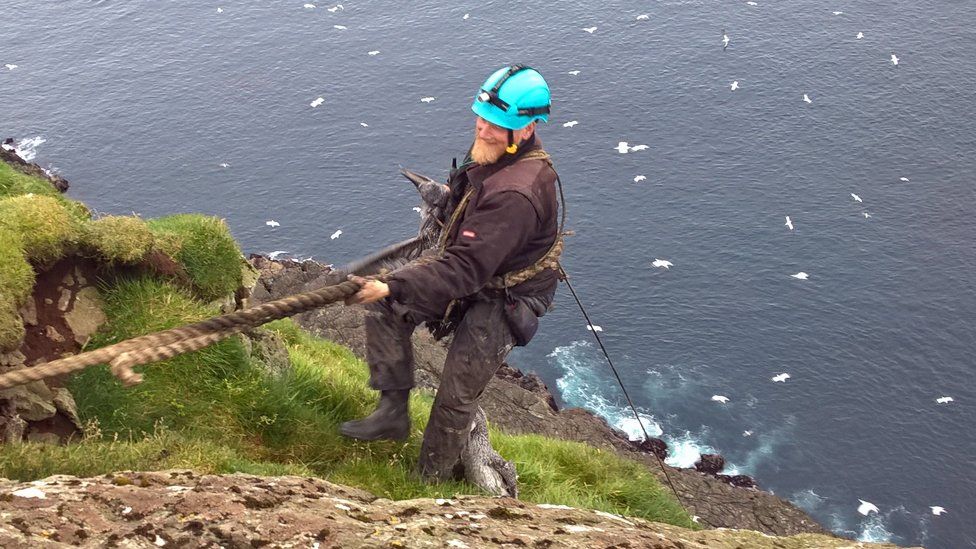Bird hunters risk steep cliffs to catch gannets
- Published

The Faroe Islands are home to an impressive array of seabirds but there is only one colony of gannets, located on the most westerly island, Mykines. The young birds are considered a delicacy by the islanders. So, once a year, hunters abseil down the cliffs to catch the birds.
It takes eight fit men to carry the 150m of thick rope which will form the essential lifeline for the bird catchers.
As thick as a man's wrist, it has to be lugged along a cliff-top path and then across a narrow gorge to the adjoining island of Mykinesholmur.
Skirting a colony of chattering puffins outside their burrows, I followed the men for an hour towards the gannet cliffs, 150m high, and dropping almost vertically into the Atlantic swell.
As dusk fell I could see the ghostly white shapes of the adult birds, cruising silently above the darkening ocean.
About 50 men had taken the small ferry out to the island to help with the hunt, essential now that Mykines's single village only has about a dozen full-time residents.
On a steep grassy incline we stopped to rest. In the half-light, food supplies were shared - bread and skerpikjot, fermented legs of lamb, which the men carved with sharp hunting knives at their belts.
Once it was dark, the final climb to the cliff edge where the birds nest began.
One by one the men stepped into a simple harness cushioned with sheep's wool, and abseiled backwards down the rock face.
The drop is sheer and within seconds they were out of sight. Once on a suitable ledge below, each of them removed the safety harness and the rope was hauled back up for the next man.
"Hiva! Hiva!" came the cry to pull together.
Once about a dozen men had been deposited on ledges out of sight, the rest of us could only wait, and in my case imagine the slaughter going on below.
Find out more
- From Our Own Correspondent has insight and analysis from BBC journalists, correspondents and writers from around the world
- Listen on iPlayer, get the podcast or listen on the BBC World Service, or on Radio 4 on Thursdays at 11:00 and Saturdays at 11:30 BST
The constant wind chilled me to the bone, and groups of men lay in the grass through the darkest hours talking about the hunt, wondering how many sula, as they are called locally, would be caught. They seemed impervious to the cold, bred in a country where even in summer it rarely gets above 16C (60F).
The hunters were sanguine about the process.
"We look forward to the gannet hunt," a young man named Johannus explained.
"The seabirds, the sheep and even the pilot whales which we catch occasionally are all part of the traditional Faroese diet. That's our culture," he insisted.
"We don't want to depend on imported food from plastic packets and eat animals kept in captivity all of their lives."
At around 04:30 in the morning a watery dawn light crept across the sea, and we returned to the rope.
Slowly and with much effort, hundreds of dead birds tied by the neck in bunches were hauled up. These chicks, just a day or two away from flying for the first time, were large, over 4kg (8lb) in weight and perhaps 80cm (30in) tall.
And then the men came. They were an extraordinary sight, faces and hands sometimes as black as if they had been down a coalmine. Reeking of the oily, fishy smell of gannet guano, many had scratched hands and ripped clothes, caused by the birds' spear-like beaks.
The last man up was Espern, the island's chief gannet catcher. Extraordinarily fit and strong he walked up the vertical cliff with the rope in one hand and two live gannets held by the neck in the other. A swift expert cut to the back of the neck and in a second the great grey creatures hung lifelessly from a beefy human hand.
But the night's work was not over.
Now the birds had to be thrown from the cliffs into the sea to be picked up by a small fishing boat which would deliver them to the village jetty. Otherwise, in rougher weather, the men would have to carry the rope and climbing equipment as well as around 500 birds, all the way back to the village.
Later, after a hearty serving of soup, we were allowed to choose two birds each, as a reward for helping raise and lower the rope during the long cold night.
We had all been up for the best part of two days and a night, but everyone was in a good mood.
"Now you know what to do, you must come again next year," said Johannus. "And maybe try going down the cliff next time."
It was a generous offer. But I know I'm simply not brave enough.
All photographs by Tim Ecott
Wives wanted
There's a shortage of women in the Faroe Islands, so local men are increasingly seeking wives from further afield - Thailand and the Philippines in particular. But what's it like for the brides who swap the tropics for this windswept archipelago?
Read: Wives wanted in the Faroe Islands (April 2017)